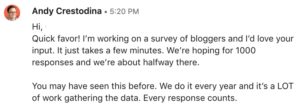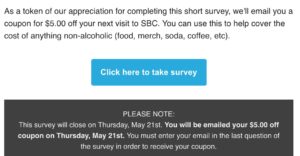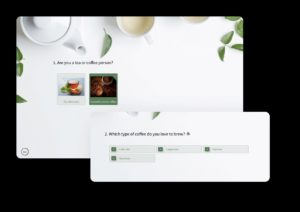Survey & Feedback
How to Write a Perfect Customer Feedback Survey Invitation?
Article written by Erica Sunarjo
8 min read
19 September 2025

Imagine yourself standing on the street, asking people to participate in a survey.
“Hello, would you be willing to answer a few questions? It’s just going to take a minute” – this is an “ice-breaker” question that you ask every person you meet.
Despite your super politeness and awesome smile, not so many people pay attention. Even fewer stop to actually help you with the survey. By the end of the day, you don’t manage to get enough responses. At that moment, it seems like you’re going to have to go back out there the next day.
Even though this is a typical situation for a survey conducted on the street, it’s not drastically different from the one you’d encounter with an online customer satisfaction survey. Why?
Because many people don’t care to answer online surveys in general.
In this post, you’re going to learn how to write a survey invitation that gets more people to participate.
Be it a pop-up window, an email, a social media message, use these six great tips to draw in customers, and get valuable feedback.
Tips to Perfect Your Customer Feedback Survey Invitation
1. Use a Customer’s Name
Your customers are busy folks. Getting their attention won’t be an easy task.
But, hey, there’s good news. You have their name and other information like interests. Also, you know how and why they use your product thanks to a great customer onboarding process. In terms of wording your invitation to attract their attention – that’s huge!
Let’s start with the simplest piece of customer information: their name. Begin your invitation by referring to the customer with it. That’s super important and gives you the best chance to get them to read more.
Be friendly and address them in a way you’d speak to someone you know:
- Hey, Mark
- Hello, Mark
- Hi, Mark.
The only exception from this rule is B2B companies that target management positions like CEOs. In this case, addressing them in a more professional way, e.g. “Mr. Ryan,” is more appropriate.
Okay, that was the easiest part. Here comes the “explanation” for your invitation, which is something we’re going to pay more attention to.
2. Explain Yourself
This tip applies to social media and email survey invitations.
Since your customers get a lot of emails daily, we need to let them know what your message is all about right away.
“Can I just say ‘I’m writing to ask you to give your feedback?’”
Of course. It’s a clear and honest explanation.
Yet, it’s not that great of an option to use. Here’s why:
It’s just too simple and boring.
To maximize the chance of the customer reading your invitation and taking the survey, let’s make it more interesting for them. That’s where your knowledge of your customer interests might come in handy.
The next sentence after the greeting should contain that engaging and informative explanation (preferably, it has to mention something they consider relevant). Here are a couple of good ideas for you, based on the real examples of survey invitations from well-known businesses.
3. Compliment the Customer
As in this email survey invitation example, the sender calls the customer “a leader in the industry.” Who wouldn’t want to be called like that?

By using these options, you’ll be able to provide a quick explanation to the customer. Next step – the body of the invitation. Here’s how to write it.
4. State the Background and Importance of the Survey
In the survey invitation below, Andy Crestodina, a well-known marketer, mentions why he sent the message and why the survey is important. All that, in one sentence, to avoid boring the recipient with unnecessary long explanations.

By using these options, you’ll be able to provide a quick explanation to the customer. Next step – the body of the invitation. Here’s how to write it.
5. Use a Conversational Writing Style
A conversational writing style is exactly what it sounds like: you write the way you speak. “It’s the best way to go for a business that needs to make survey invitations feel more genuine,” explains Angela Baker, an expert copywriter from TrustMyPaper. “After all, you don’t write in an impersonal style of, say, essays, but in your own words, like social media messages.”
Here’s one more example from Crestodina. Notice how concise every sentence is and how easy it is to read the invitation.

The style makes it feel like it’s a conversation because the sender wrote it in his own words. If you’d like to use the same style, avoid:
- complex words
- very long sentences
- long paragraphs (4 sentences and more).
One great way to start with conversational language is to write a draft version of the invitation and then look for ways to cut the length as soon as possible. If you’d like some expert writing help with making your invitations more concise, use online writing services like TopEssayWriting and Hemingway Editor. They’ll help to avoid a common writing mistake: unnecessary wordiness that bores potential survey takers.
Pro tip: make conversational customer surveys. This style makes the questions easier to understand, which can increase participation rates. Also, natural language can make the survey more engaging for the customer.
For example, instead of “Do you prefer tea or coffee?” which sounds a bit generic, you can ask, “Are you a tea or coffee person?”
6. Mention Survey Time
This one is critical. As you may have mentioned, the previous example of the survey invitation contains a hint about how much time it takes to complete it (“It just takes a few minutes.”) That sentence, of course, is there for a reason.
By making it clear right away, you’re showing the customer that the survey won’t take a lot of their time.
Here are some great options for you to consider:
- “If you could provide a few minutes of your time…”
- “The survey just takes several minutes…”
- “We would greatly appreciate a few minutes of your time…”
Learn more: A Guide to Writing Survey Questions that Get More Answers
7. Make Them Feel Special
To encourage people to take the survey, you can try ending it with something that makes them feel special. One great way is to promise them to send an early version of the survey report before you share them on your website.
Here’s how you can put it into words.
![]()
Make it one sentence to avoid taking up too much time. Remember that your goal is to let the customers know that they can get the results earlier than others.
8. Give an Incentive
Also, you can share small gifts like an Amazon gift card or an extended free trial of your product. The choice of the incentive depends on the value of the results, so if the survey is super critical for you, definitely consider using these techniques.
Saugatuck Brewing Company, for example, promises a $5 coupon to customers in this online survey invitation below. Note that this is mentioned right before the call-to-action (CTA) button – this is a deliberate tactic!
 By mentioning the incentive so close to the CTA, you can increase the motivation of the customer to click it. With online survey software that integrates with online reward management tools, you can easily share coupons, gift cards, and other incentives.
By mentioning the incentive so close to the CTA, you can increase the motivation of the customer to click it. With online survey software that integrates with online reward management tools, you can easily share coupons, gift cards, and other incentives.
Conclusion
These are the steps to take to make a perfect customer feedback survey invitation. As you can see, writing one isn’t really that difficult, but make sure to create multiple versions for experimentation. Some invitations might attract more responses than others, so some A/B testing will definitely be useful.

Create engaging surveys that people actually complete. Try SurveySparrow now!
Erica Sunarjo
Related Articles

Survey & Feedback
How to Make Your Surveys More Accessible With Voice and Audio Features?
8 MINUTES
8 December 2025

Survey & Feedback
Training Needs Survey Questions for Employees: Examples (+ Free Template)
6 MINUTES
13 May 2022

Survey & Feedback
Revolutionize Survey Feedback with SurveySparrow's Advanced Data Analytics & Visualizations
10 MINUTES
27 April 2023

Survey & Feedback
Having awful meetings on an otherwise nice day? Let’s change it
3 MINUTES
17 July 2020

